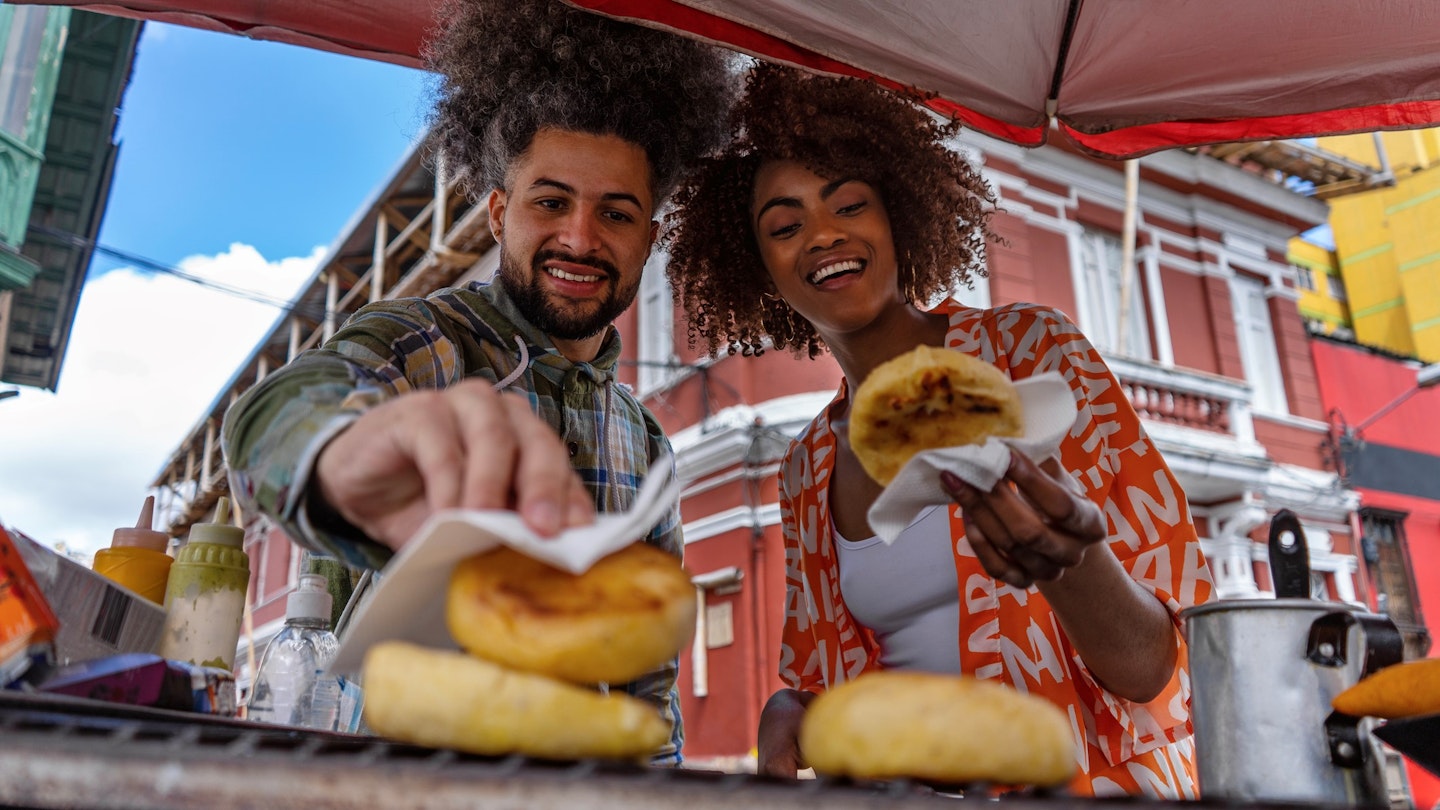Inspired by age-old indigenous and European influences, Colombian cuisine reflects the incredible cultural and geographic diversity of the country with delectable regional specialties found in both the mountainous interior and along the coastal plains.
While preparations vary greatly between destinations, one common factor is that meals are always prepared with plenty of farm-fresh produce, a reflection of the country’s productive climate and incredibly fertile lands.
With two very different coasts and a multitude of rivers flowing down from the mountains, there’s plenty of fish and seafood to be sampled. Furthermore, there is no better way to finish a meal than to sample some of the country’s extraordinary variety of fresh fruits – many of which never grace the shelves of grocers in other parts of the world.
Best Foods to Try in Colombia
Bandeja paisa
Originating in Antioquia but now enjoyed all over the country, this belly-bursting paisa platter is a high-calorie feast designed to keep hardy rural folk working in the mountains all day. While it may seem excessive, there’s no denying it’s delicious.
According to purists, a real bandeja paisa must include 10 ingredients: rice, beans, pork rinds, ground beef, sausage, egg, black pudding, avocado, grilled plantain, and arepa. Interestingly, it should only be served on an oval-shaped plate.
Hormigas culonas
One of Colombia’s most intriguing culinary traditions has its origins in the pre-Hispanic indigenous communities of Santander, who harvested giant flying ants as a readily available source of protein.
Eaten as a snack, hormigas culonas – literally fat-arsed ants – are toasted in a pan over an open flame. Only the females are eaten, while the males are deemed too meager. While some find the flavor reminiscent of coffee grounds with a hint of dirt, others consider them the caviar of the Andes. Buy a packet and decide for yourself!
Cazuela de Mariscos
Popular on both coasts, this rich dish of mixed seafood in creamy coconut sauce may not help your diet, but it will certainly tantalize your taste buds. Most versions include fish, shrimp, and squid, along with many other delicacies.
This dish is usually served with fried green plantain and lemonade sweetened with panela to cleanse the palate.
Tamales
With strong indigenous origins, the unassuming tamal is arguably Colombia’s most underrated gourmet surprise. Made of spiced maize meal with meat and vegetables wrapped in a banana leaf, it may not look significant at first glance; however, the delightful aroma will win you over once the natural packaging is opened.
In a well-prepared tamale, the juices from the meat and vegetables seep into the base but retain firmness without becoming soggy. Various tamale versions exist across the country, but those from the Tolima department are often considered the best.
Sancocho
The king of Colombia’s many soups, sancocho is a slow-cooked hearty dish featuring various meats, plantain, and cassava.
Traditionally prepared over a smoky wood fire, a great sancocho has a delightful brown color. Classic versions include sancocho de gallina, made with a free-range hen, and sancocho trifásico, which contains pork, beef, and chicken. Lighter versions made with fish are also popular.
Arepas
Nothing divides opinion among visitors to Colombia quite like the humble arepa. This grilled flat cake made from maize is virtually omnipresent at mealtimes and is also a popular quick snack. The various types of arepas are endless.
Seek out toasty arepas Santanderenas, in which yellow maize flour is combined with ground pork rinds, or indulge in sweet arepas de chocolo, best enjoyed with fresh white cheese.
Helado de paila
Made right before your eyes in a bronze bowl situated on a large block of ice, helado de paila is a delicious ice cream found in the far southern regions of Colombia. With just a handful of all-natural ingredients, primarily creamy fresh buttermilk, it stands among the healthiest forms of ice cream.
It’s said that the first versions were made using ice brought down from mountain glaciers. Today, although the ice is now supplied by wholesalers, the technique remains unchanged as generations have passed.
Empanadas
A beloved snack across all demographics, the empanada is Colombia’s favorite street food. This fried maize pastry, typically filled with seasoned meat and served alongside a vinegary hot sauce, is popular in small carts and eateries throughout the country. These delectable pastries are often enjoyed as a mid-morning bite or alongside drinks, yet they can be appreciated at any time.
Ajiaco
Ajiaco, Bogotá’s signature dish, is a creamy chicken and creole potato soup infused with capers and wild mountain herbs. Rooted in colonial history, it’s perfect for warming up during chilly afternoons in the capital.
This nutrient-packed dish is considered one of the healthiest among Colombia’s traditional offerings, and if you enjoy it, trying another famous Bogotano option for breakfast—the milky, herb-infused changua—is highly recommended.
For Vegetarians and Vegans
As the number of vegetarians rises, finding meat-free options in Colombia is becoming easier, although only about 5% of the population currently identifies as vegetarian. Nevertheless, even medium-sized cities often boast dedicated vegan and vegetarian restaurants. Furthermore, many Colombian restaurant chains offer several vegetable-based mains, clearly marked on their menus.
In more rural areas, options can be limited. However, with an abundance of fresh fruits and vegetables available, Colombia remains a beneficial destination for herbivores. Beans, chickpeas, and various legumes accompany meals at simple restaurants across the country. Be cautious, though, as many are typically flavored with meat stock. Most street snacks offer vegetarian-friendly options, although they are often loaded with cheese, making them less suitable for vegans.





